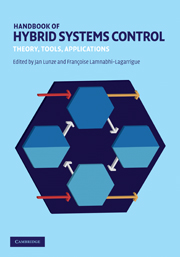17 - Solar air conditioning – a benchmark for hybrid systems control
from Part III - Applications
Published online by Cambridge University Press: 21 February 2011
Summary
By considering a solar air conditioning plant, the typical steps for analyzing and controlling hybrid systems under practical circumstances are described in this chapter.
Plant description
The present chapter describes the application and the implementation of a hybrid control scheme of a solar air conditioning plant. The conditioning plant considered is a hybrid system characterized by a variable configuration, with discrete and continuous variables, and components that change their dynamics according to the conditions under which the plant operates. Section 17.1 describes the solar air conditioning plant. Section 17.2 shows briefly the hybrid modeling of the plant. Section 17.3.1 describes the control requirements to operate the plant. Section 17.3.2 develops a hybrid control strategies for the operation of the plant. Section 17.3.3 shows the experimental results and discusses them.
Main components
The solar air conditioning plant considered in this chapter is located in Seville (Spain) and is used to cool down the laboratories of the Department of System Engineering and Automation of the University of Seville. It consists of a solar field producing hot water that feeds into an absorption machine, generating chilled water and injecting it into the air distribution system, which has a cooling power of 35 kW.
Figure 17.1 offers a general scheme of the plant, and shows its main components: the solar subsystem, composed of a set of flat solar collectors; the accumulation subsystem, composed of two tanks storing hot water; and the cooling machine.
- Type
- Chapter
- Information
- Handbook of Hybrid Systems ControlTheory, Tools, Applications, pp. 501 - 510Publisher: Cambridge University PressPrint publication year: 2009

